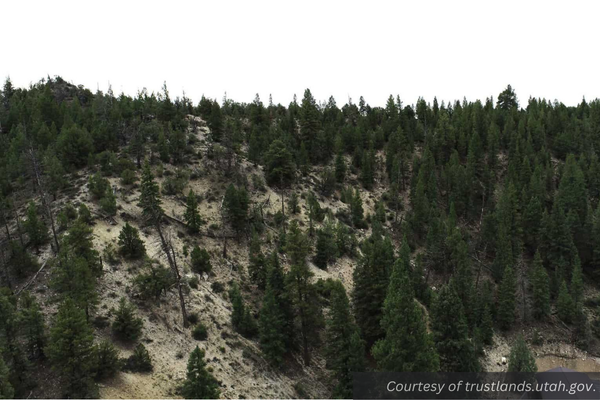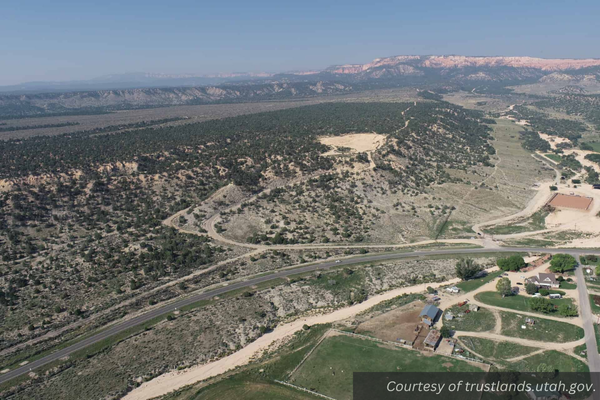After The Byway’s most recent article about trust land parcels east of Cannonville, we received a few comments regarding the School and Institutional Trust Lands Administration (SITLA) and their treatment of land sales.
People living near rural Utah’s millions of acres of federally-owned Bureau of Land Management land tend to view SITLA lands as Utah’s version of that — another way of saying public land. This view is reinforced by the fact that trust land is often leased to ranchers or used for recreation, just as BLM land is.
Others, especially those living along the Wasatch front, also view SITLA as Utah’s version of a land management agency. Though they don’t fully understand the BLM either, some imagine that if Utah acquires the federal government’s 18.5 million acres of unappropriated land in the state, those lands will be absorbed into the trust lands SITLA operates.
But SITLA-owned land is not public land.
Since a majority of Utahns do not have a clear idea what SITLA is, The Byway editors felt a deeper look into this topic would be of use.
What Is SITLA?
SITLA, now going by the shorter name Trust Lands Administration, is an independent state agency (meaning it is not part of the executive branch like most agencies are) that holds stewardship over Utah’s 3.3 million acres of school trust lands.
SITLA was only created in 1994, when it was split from the Division of Natural Resources, but trust lands have existed since the state’s founding.
When states are created, the federal government also grants trust lands for public education revenue. The Enabling Act that made Utah a state in 1894 requires “that the proceeds of lands herein granted for educational purposes, except as hereinafter otherwise provided, shall constitute a permanent school fund.” The state Constitution likewise establishes the permanent school fund and outlines that it consist of “all revenues derived from the use of school trust lands.”
In short, trust lands are to be used to generate revenue for public schools and institutions. Hence SITLA’s existence.
From SITLA’s website, it is clear that misunderstandings about its purpose are common. But the agency is very transparent about its activities. There are four ways SITLA generates revenue on trust land: sales and leases, energy and materials, real estate planning and development, and surface resources.
Priorities are decided according to expected revenue. “In most years, energy & minerals generates the largest portion of revenue,” says the SITLA website. “However, last year most of the revenue was generated by real estate.”
Land sales and leases are a regular occurance and usually not controversial. Auctions are held every June and November.
Readers interested in exploring SITLA’s land use further can find information about each on SITLA’s website, trustlands.utah.gov.

Where Does Revenue Generated from Trust Lands Go?
After SITLA generates revenue on the land, it passes the torch.
Ninety-six percent of the revenue generated from trust lands goes to public education through the permanent school fund. This fund is managed by the School and Institutional Trust Funds Office, a branch of SITLA created legislatively in 2014. Some of the money also goes to a few of Utah’s reservoirs, hospitals, justice centers, and public buildings.
In the last thirty years, the permanent school fund has grown from about $50 million to around $3.2 billion.
Every year SITLA releases its distributions based on enrollment for each school in the state. These are the numbers from along the Byway last year:
| High Schools | |
| Piute: | $140,943 |
| Wayne: | $89,035 |
| Panguitch: | $49,558 |
| Bryce Valley: | $41,766 |
| Escalante: | $23,065 |
| Lake Powell: | $1,157 |
| Middle Schools | |
| Wayne: | $55,965 |
| Panguitch: | $22,441 |
| Elementary Schools | |
| Circleville: | $83,196 |
| Oscarson: | $30,342 |
| Koosharem: | $6,966 |
| Loa: | $125,922 |
| Hanksville: | $7,632 |
| Panguitch: | $65,454 |
| Bryce Valley: | $47,376 |
| Escalante: | $26,181 |
| Boulder: | $3,740 |
| Antimony: | $4,675 |
Does Utah’s Public Lands Lawsuit Have Anything to Do with SITLA?
Utah is currently suing the federal government for control of 18.5 million acres unappropriated BLM lands in the state. Since trust lands are not public lands, this will not involve SITLA at all, even if Utah wins the lawsuit.
If Utah wins, a new Utah Department of Land Management would come into existence. This new department would have no connection to either the Department of Natural Resources, which manages Utah’s state parks, or the Trust Lands Administration, which manages Utah’s trust lands.
By way of information, the Department of Land Management has its own rules and missions, mostly focusing on multiple use. Utah law prohibits privatization of these public lands except in rare situations.
Public Officials’ Criticisms of SITLA
The Office of the State Auditor audits SITLA every year as part of the State’s Annual Comprehensive Financial Report.
Recently the Legislative Auditor General also did a performance audit of SITLA at the request of the Utah legislature. According to the audit, “There were no identified instances where trust fund revenue was allocated to the wrong beneficiary,” but it did show quite a few ways SITLA could improve its practices.
The audit showed SITLA has made at least one risky acquisition in the last three years. It also has “limited review” of staff decisions, doesn’t have a “comprehensive inventory of the value and characteristics of its land” to track changes in property values, and could improve its mechanisms for accountability to the public.
SITLA has been criticized for canceling leases from under the feet of ranchers, like what happened to the Otts in Garfield County a few years ago. It has also been accused of leaning too heavily on the obligation to generate revenue as an excuse to be greedy.
Garfield County Commissioner Leland Pollock has often lamented that SITLA has “become a real estate company” rather than working with the needs of local people and leaders.
– by Abbie Call
Feature image caption: An aerial view of an approximately 38-acre parcel on Merrill’s Bench within the Tropic city limits. The parcel was posted for sale in SITLA’s November auction, but it was not sold. Highway 12 runs through the corner of the parcel along with a few county roads. The parcel is currently leased for grazing.

Abbie Call – Cannonville/Kirksville, Missouri
Abbie Call is a journalist and editor at The Byway. She graduated in 2022 with a bachelor’s degree in editing and publishing from Brigham Young University. Her favorite topics to write about include anything local, Utah’s megadrought, and mental health and meaning in life. In her free time, she enjoys reading, hanging out with family, quilting and hiking.
Find Abbie on Threads @abbieb.call or contact her at abbiecall27@gmail.com.

